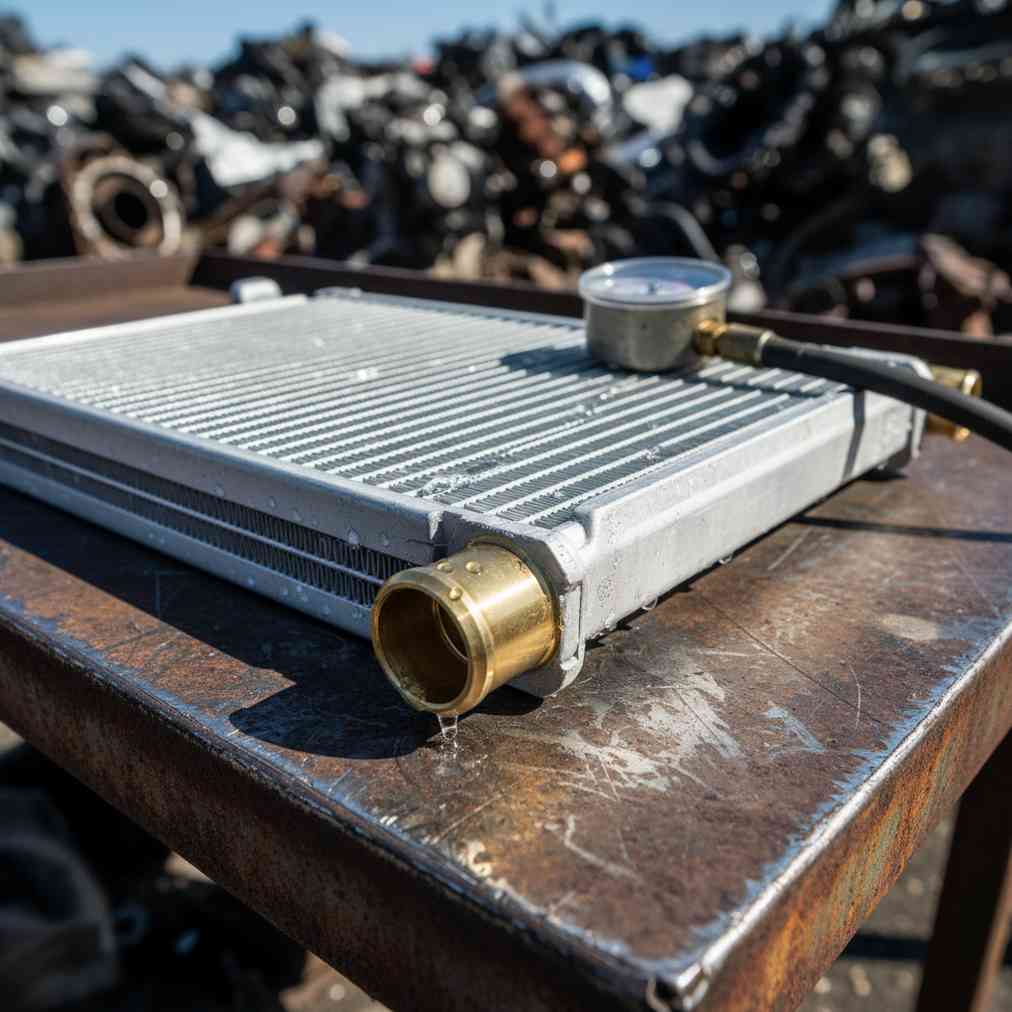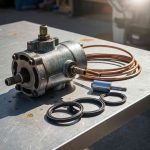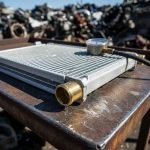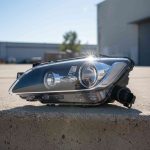Understanding Your Car’s Cooling System
A car’s radiator serves as the heart of the cooling system, working alongside other critical parts to regulate engine temperature and prevent costly overheating damage. The cooling system circulates coolant—a mixture of water and antifreeze—through the engine to absorb excess heat, then transfers that heat to the outside air through the radiator’s heat-exchange process.
The system includes several key parts working in harmony: the water pump circulates coolant, the thermostat regulates flow based on temperature, radiator hoses transport fluid between parts, and cooling fans draw air through the radiator fins. When any part fails, especially the radiator, engine overheating can occur within minutes, potentially causing thousands of dollars in damage.
Why Buy Used Radiators? The Smart Financial Choice
Purchasing used radiators from salvage yards near you offers significant advantages for budget-conscious car owners. Used OEM radiators typically cost 60-70% less than new parts while maintaining the same quality and specifications as the original equipment.
- Cost Savings: Save hundreds of dollars compared to new radiator prices
- OEM Quality: Get original manufacturer parts that may no longer be available new
- Environmental Benefits: Reduce waste by giving functional parts a second life
- Availability: Find parts for older or discontinued vehicle models
For owners of older vehicles, used OEM parts often provide better reliability than aftermarket alternatives, especially when properly inspected and tested before purchase.
Pre-Purchase Inspection: Your Complete Checklist
A thorough visual inspection is your first line of defense against buying a defective radiator. Before any testing, examine the entire unit for obvious signs of damage or previous repairs.
| Inspection Area | What to Look For | Red Flags |
|---|---|---|
| External Surface | Overall condition and cleanliness | Corrosion, rust stains, dried coolant residue |
| Cooling Fins | Straight, intact fin structure | Bent, damaged, or blocked fins |
| Tanks & Seams | Solid connections between tanks and core | Cracks, separation, or previous repairs |
| Inlet/Outlet Necks | Clean, undamaged hose connections | Cracks, chips, or deformation |
| Mounting Points | Secure, undamaged mounting brackets | Broken tabs, missing hardware |
Core Inspection Techniques
The radiator core contains hundreds of small tubes that facilitate heat transfer. Use these professional techniques to assess core condition:
- Flashlight Test: Shine light through the fins to check for blockages or internal damage
- Airflow Check: Use compressed air to clear debris and test for obstructions
- Tube Integrity: Look for collapsed, crushed, or corroded tubes within the core matrix
- Fin Condition: Ensure fins aren’t touching or severely bent, which reduces cooling efficiency
“The core is the radiator’s heat-exchange matrix. Any significant damage here can compromise the entire cooling system’s effectiveness, leading to engine overheating even with proper coolant levels.”
MOTOR Magazine Technical Review
Pressure Testing: The Ultimate Leak Detection Method
Pressure testing is the most reliable method to identify hidden leaks in used radiators. This process involves pressurizing the radiator beyond normal operating pressure to reveal pinhole leaks and hairline cracks invisible during visual inspection.
Professional Pressure Testing Steps
- Equipment Setup: Use a radiator pressure tester with proper adapters for the radiator cap opening
- Pressure Application: Apply 1.5-2 times the normal operating pressure (typically 15-20 PSI)
- Hold Time: Maintain pressure for 10-15 minutes while monitoring the gauge
- Visual Inspection: Look for coolant seepage, bubble formation, or pressure drops
- Water Submersion: For thorough testing, submerge the pressurized radiator and watch for air bubbles
According to cooling system experts, any pressure drop exceeding 2 PSI over 15 minutes indicates a leak requiring repair or part replacement.
Hose and Connection Assessment
Even the best radiator will fail if connected with deteriorated hoses and clamps. Many cooling system failures occur at connection points rather than the radiator itself.
| Part | Inspection Method | Replacement Interval |
|---|---|---|
| Radiator Hoses | Check for hardness, cracks, and internal deterioration | Every 36,000-50,000 miles |
| Hose Clamps | Ensure proper tightness and no corrosion | Replace with hoses |
| Radiator Cap | Pressure test to verify proper sealing | Every 2-3 years |
| Thermostat | Test opening temperature accuracy | Every 100,000 miles |
When buying a used radiator, budget for new hoses and clamps as these parts often fail due to age-related deterioration rather than mechanical damage. Professional mechanics recommend replacing all rubber parts when installing any major cooling system part.
Where to Find Quality Used Radiators
Finding reliable used radiators requires knowing where to look and what questions to ask. Professional auto recyclers offer the best combination of quality, testing, and warranty protection.
Best Sources for Used Radiators
- Professional Salvage Yards: Offer tested parts with limited warranties
- Self-Service Yards: Lower prices but require your own testing and removal
- Online Marketplaces: Wide selection but limited inspection opportunities
- Radiator Shops: Rebuilt radiators with professional warranties
When shopping for used radiators, always ask about the vehicle’s history. Radiators from accident-free vehicles with regular maintenance typically offer the best reliability and remaining service life.
Expert Tips for Smart Buyers
Industry professionals recommend several strategies to maximize your chances of finding a leak-free used radiator:
- Check Vehicle Age: Target radiators from vehicles less than 10 years old for maximum remaining life
- Verify Part Numbers: Ensure exact compatibility with your vehicle’s cooling system specifications
- Ask About Testing: Choose sellers who perform pressure testing before sale
- Request Warranties: Look for parts with at least 30-day return policies
- Consider Professional Installation: Have qualified mechanics install and test the system
“Hoses can rot internally from electrolytic corrosion. They typically should be replaced about every 36,000 to 50,000 miles, but check the carmaker’s recommendation.”
MOTOR Magazine Professional Guide
Installation and Testing Best Practices
Proper installation and initial testing are crucial for ensuring your used radiator performs reliably. Professional installation includes system flushing, pressure testing, and thermal cycling to verify operation.
Post-Installation Checklist
- System Flush: Remove old coolant and debris before adding fresh coolant
- Pressure Test: Verify system holds proper pressure without leaks
- Thermostat Check: Ensure proper coolant flow and temperature regulation
- Fan Operation: Test cooling fan engagement and airflow
- Road Test: Monitor temperatures during normal driving conditions
If you’re planning to sell your current vehicle, consider getting an instant quote for your junk car to help offset the cost of radiator replacement on your primary vehicle.
Recent Industry Trends and Developments
The used auto parts industry continues evolving with new technologies and practices that benefit radiator buyers:
- Digital Inventory Systems: Online databases help locate specific radiator models quickly
- Improved Testing Equipment: Advanced pressure testing and core analysis tools
- Extended Warranties: More salvage yards offering longer warranty periods
- Environmental Focus: Increased emphasis on recycling and remanufacturing
Modern testing methods allow buyers to verify radiator condition with greater confidence, reducing the risk of purchasing defective parts.
Critical Statistics Every Buyer Should Know
| Metric | Value | Impact |
|---|---|---|
| Heat Conversion Rate | 70% of fuel energy becomes heat | Demonstrates cooling system importance |
| Pressure Effect | Each 1 PSI raises boiling point 3°F | Why proper cap pressure matters |
| Typical Lifespan | 10+ years with proper maintenance | Expected service life for quality radiators |
| Cost Savings | 60-70% less than new parts | Financial benefit of used radiators |
Conclusion: Smart Shopping for Reliable Cooling
Finding and buying leak-free used radiators requires careful inspection, proper testing, and smart shopping practices. By following professional inspection guidelines, conducting thorough pressure tests, and purchasing from reputable sources, you can save significant money while ensuring reliable cooling system performance.
Remember that comprehensive inspection is your best protection against costly mistakes. Take time to examine the core, test for leaks, and verify all connections before making your purchase. With proper preparation and knowledge, used radiators can provide years of reliable service at a fraction of new part costs.
Whether you’re maintaining an older vehicle or looking to reduce repair costs, quality used radiators offer an excellent balance of performance, reliability, and affordability when chosen and installed correctly.





Leave a Reply
You must be logged in to post a comment.